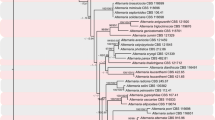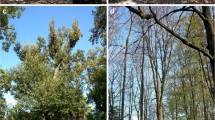Abstract
Duosporium is a monotypic genus including only the type species Duosporium yamadanum which has been treated in the literature as “anamorphic Pezizomycotina.” Nevertheless, this is just a conjecture since its true phylogenetic affinities remain unknown. This fungus is known to cause leaf spots on several members of Cyperus spp. It has been intensively investigated in the 1990s as a potential candidate for use as an inundative biocontrol agent against purple nutsedge—a major tropical weed. Its morphology was recognized, as somewhat close to those of Curvularia and Bipolaris. Nevertheless, it was kept in a separate genus based on two distinctive morphological features: production of two kinds of spores (as indicated by its generic name) and straight versicolored macroconidia. No molecular studies have ever been made to elucidate the placement of Duosporium. In a relatively recent publication, Curvularia americana and C. chlamydospora were found to produce macro- and microconidia, as in Duosporium. Besides, there are several species of Curvularia known to have predominantly straight conidia. Here, a multilocus phylogenetic analysis including the internal transcribed spacer regions and intervening 5.8S nrRNA gene (ITS) and translation elongation factor 1-α (TEF1) sequences placed D. yamadanum within Curvularia, close to C. tuberculata, C. oryzae, and C. reesi. This led to the proposal of the new combination C. yamadana and the synonymization of Duosporium with Curvularia.


Similar content being viewed by others
References
Barreto RW, Evans HC (1995) Mycobiota of the weed Cyperus rotundus in the state of Rio de Janeiro, with an elucidation of its associated Puccinia complex. Mycol Res 98:1107–1116. https://doi.org/10.1016/s0953-7562(09)80638-2
Cai L, Udayanga D, Manamgoda DS, Maharachchikumbura SS et al (2011) The need to carry out re-inventory of plant pathogenic fungi. Trop Plant Pathol 36:205–213. https://doi.org/10.1590/S1982-56762011000400001
da Cunha KC, Sutton DA, Fothergill AW, Gene J et al (2013) In vitro antifungal susceptibility and molecular identity of 99 clinical isolates of the opportunistic fungal genus Curvularia. Diagn Microbiol Infect Dis 76:168–174. https://doi.org/10.1016/j.diagmicrobio.2013.02.034
Dhingra OD, Sinclair JB (1995) Basic plant pathology methods. CRC Press, Boca Raton
Edenfield MW, Brecke BJ, Colvin DL, Dusky JA et al (2005) Purple nutsedge (Cyperus rotundus) control with glyphosate in soybean and cotton. Weed Technol 19:947–953. https://doi.org/10.1614/WT-03-232R1.1
Edgar RC (2004) MUSCLE: multiple sequence alignment with high accuracy and high throughput. Nucleic Acids Res 32:1792–1797. https://doi.org/10.1093/nar/gkh340
Ellis MB (1971) Dematiaceous Hyphomycetes. Commonwealth Mycological Institute, Kew
Farr DF, Rossman AY (2020) Fungal databases, systematic mycology and microbiology laboratory, ARS, USDA Available at: http://ntars-gringov/fungaldatabases/Accessed 10 Jan 2020
Ferreira BW, Barreto RW (2019) Debunking Acroconidiella. Mycol Prog 18:1303–1315. https://doi.org/10.1007/s11557-019-01525-y
Hepperle D (2004) SeqAssem©. Win32–Version. A sequence analysis tool contig assembler and trace data visualization tool for molecular sequences. Available at: http://www.sequentix.de. Accessed 3 Jan 2020
Hernández-Restrepo M, Madrid H, Tan YP, da Cunha KC et al (2018) Multi-locus phylogeny and taxonomy of Exserohilum. Persoonia 41:71–108. https://doi.org/10.3767/persoonia.2018.41.05
Holm LG, Plucknett DL, Pancho JV, Herberger JP (1991) The world’s worst weeds: distribution and biology. Krieger Publishing Company, Malabar
Hyde KD, Nilsson RH, Alias SA, Ariyawansa HA et al (2014) One stop shop: backbone trees for important phytopathogenic genera: I. Fungal Divers 67:21–125. https://doi.org/10.1007/s13225-014-0298-1
Kirk PM, Cannon PF, Minter DW, Stalpers JA (2008) Dictionary of the fungi. CAB International, Wallinford
Macedo DM (2006) Duosporium yamadanum: Produção massal, formulação e associação com herbicidas para o controle de tiririca. MSc thesis. Universidade Federal de Viçosa
Maddison WP, Maddison DR (2011) Mesquite: a modular system for evolutionary analysis. Version 3.51 http://www.mesquiteproject.org. Accessed 3 Jan 2020
Madrid H, da Cunha KC, Gené J, Dijksterhuis J et al (2014) Novel Curvularia species from clinical specimens. Persoonia 33:48–60. https://doi.org/10.3767/003158514X683538
Manamgoda DS, Cai L, McKenzie EHC, Crous PW et al (2012a) A phylogenetic and taxonomic re-evaluation of the Bipolaris–Cochliobolus–Curvularia complex. Fungal Divers 56:131–144. https://doi.org/10.1007/s13225-012-0189-2
Manamgoda DS, Cai L, McKenzie EHC, Chukeatirote Eet al. (2012b) Two new Curvularia species from northern Thailand. Sydowia 64:255–266
Manamgoda DS, Rossman AY, Castlebury LA, Crous PW et al (2014) The genus Bipolaris. Stud Mycol 79:221–288. https://doi.org/10.1016/j.simyco.2014.10.002
Manamgoda DS, Rossman AY, Castlebury LA, Chukeatirote Eet al. (2015) A taxonomic and phylogenetic re-appraisal of the genus Curvularia (Pleosporaceae): human and plant pathogens. Phytotaxa 212:175–198. https://doi.org/10.11646/phytotaxa.212.3.1
Marin-Felix Y, Senwanna C, Cheewangkoon R, Crous PW (2017) New species and records of Bipolaris and Curvularia from Thailand. Mycosphere 8:1556–1574. https://doi.org/10.5943/mycosphere/8/9/11
Matsushima T (1980) Saprophytic microfungi from Taiwan, part 1. Hyphomycetes. Matsushima Mycological Memoirs 1:1–82
Matsuura I (1931) Studies on the plant diseases caused by Brachysporium. A new disease, leaf blight of Cyperus iwasakii. Journal of Plant Protection 17:413–419
Mercado Sierra A (1984) Hifomicetes Demaciaceos de Sierra del Rosario, Cuba. Editorial Academica, Havana
Miller MA, Pfeiffer W, Schwartz T (2010) Creating the CIPRES Science Gateway for inference of large phylogenetic trees. In: Proceedings of the Gateway Computing Environments Workshop (GCE), New Orleans, pp 1–8
Minter DW, Rodriguez-Hernandez M, Mena-Portales J (2001) Fungi of the Caribbean: an annotated checklist. PDMS Publishing
Pereira JM, Barreto RW, Ellison CA, Maffia LA (2003) Corynespora cassiicola f. sp. lantanae: a potential biocontrol agent for Lantana camara from Brazil. Biol Control 26:21–31. https://doi.org/10.1016/S1049-9644(02)00112-3
Pinho DB, Firmino AL, Pereira OL, Ferreira Junior WG (2012) An efficient protocol for DNA extraction from Meliolales and the description of Meliola centellae sp. nov. Mycotaxon 122:333–345. https://doi.org/10.5248/122.333
Pomella AWV (1999) Avaliação do fungo Duosporium yamadanum no controle biológico da tiririca (Cyperus rotundus). DSc thesis. Universidade Federal de Viçosa
Posada D, Buckley TR (2004) Model selection and model averaging in phylogenetics: advantages of Akaike information criterion and Bayesian approaches over likelihood ratio tests. Syst Biol 53:793–808. https://doi.org/10.1080/10635150490522304
Rayner RW (1970) A mycological colour chart. CMI and British Mycological Society, Kew
Raza M, Zhang ZF, Hyde KD, Diao YZ, Cai L (2019) Culturable plant pathogenic fungi associated with sugarcane in southern China. Fungal Divers 99:1–104. https://doi.org/10.1007/s13225-019-00434-5
Schoch C, Crous PW, Groenewald J, Boehm E et al (2009) A class-wide phylogenetic assessment of Dothideomycetes. Stud Mycol 64:1–15. https://doi.org/10.3114/sim.2009.64.01
Sivanesan A (1987) Graminicolous species of Bipolaris, Curvularia, Drechslera, Exserohilum and their teleomorphs. Myc Papers 158:1–261. https://doi.org/10.2307/3759472
Tamura K, Peterson D, Peterson N, Stecher G et al (2011) MEGA5: molecular evolutionary genetics analysis using maximum likelihood, evolutionary distance, and maximum parsimony methods. Mol Biol Evol 28:2731–2739. https://doi.org/10.1093/molbev/msr121
Tan YP, Crous PW, Shivas RG (2016) Eight novel Bipolaris species identified from John L. Alcorn’s collections at the Queensland Plant Pathology Herbarium (BRIP). Mycol Prog 15:1203–1214. https://doi.org/10.1007/s11557-016-1240-6
Tan YP, Crous PW, Shivas RG (2018) Cryptic species of Curvularia in the culture collection of the Queensland Plant Pathology Herbarium. MycoKeys 35:1. https://doi.org/10.3897/mycokeys.35.25665
Thind KN, Rawla GS (1961) A new fungus on Cyperus iria. Am J Bot 48:859–862. https://doi.org/10.1002/j.1537-2197.1961.tb11722.x
Tsuda M, Ueyama A (1982) Duosporium yamadanum, a pathogen of Cyperus spp. Mycotaxon 14:145–148
Urtiaga R (1986) Indice de enfermedades en plantas de Venezuela y Cuba. Nuevo Siglo, Venezuela
White TJ, Bruns T, Lee S, Taylor J (1990) Amplification and direct sequencing of fungal ribosomal RNA genes for phylogenetics. In: Innis MA, Gelfand DH, Sninsky JJ, White TJ (eds) PCR protocols: a guide to methods and applications. Academic Press, New York, pp 315–322
William RD (1976) Purple nutsedge: tropical scourge. Hortscience 11:357–364
Woudenberg JH, Groenewald JZ, Binder M, Crous PW (2013) Alternaria redefined. Stud Mycol 75:171–212. https://doi.org/10.3114/sim0015
Funding
This study received financial support from the Conselho Nacional de Desenvolvimento Científico e Tecnológico (CNPq), Fundação de Amparo à Pesquisa do Estado de Minas Gerais (FAPEMIG), and the Coordenação de Aperfeiçoamento de Pessoal de Nível Superior (CAPES).
Author information
Authors and Affiliations
Corresponding author
Additional information
Section Editor: Marc Stadler
Publisher’s note
Springer Nature remains neutral with regard to jurisdictional claims in published maps and institutional affiliations.
Rights and permissions
About this article
Cite this article
Ferreira, B.W., Barreto, R.W. Debunking Duosporium. Mycol Progress 19, 715–723 (2020). https://doi.org/10.1007/s11557-020-01592-6
Received:
Revised:
Accepted:
Published:
Issue Date:
DOI: https://doi.org/10.1007/s11557-020-01592-6




